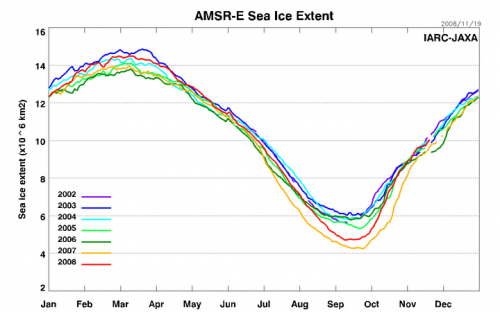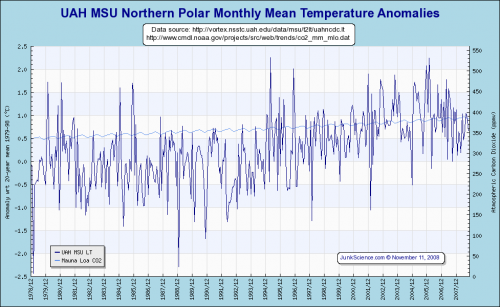My company runs a snow play area north of Flagstaff, Arizona. One of the problems with this location is that the main sledding runs are on a black cinder hill. Covered in snow, this is irrelevant. But once the smallest hole opens up to reveal the black cinders underneath, the hole opens and spreads like crazy. The low albedo cinders absorb heat much faster than reflective white snow, and then spread that heat into the snow and melts it.
Anthony Watt does an experiment with ash and snow in his backyard, and the effects are dramatic.
Even tiny amounts of soot pollution can induce high amounts of melting. There is little or no ash at upper right.. Small amounts of ash in the lower and left areas of the photo cause significant melting at the two-hour mark in the demonstration.
I won’t steal his thunder by taking his pictures, but you should look at them — as the saying goes, they are worth a thousand words.
We know that Chinese coal plants pump out a lot of black carbon soot that travels around the world and deposits itself over much of the norther hemisphere. We can be pretty sure a lot of this carbon ends up on the Arctic ice cap, and as such contributes to an acceleration of melting.
I’v tried to do a thought experiment to think about what we would expect to see if this soot was driving a measurable percentage of Arctic ice melt. It seems fairly certain that the soot would have limited effects during the season when new snow is falling. Even a thin layer of new snow on top of deposited carbon would help mitigate its albedo-reducing effect. So we would expect winter ice to look about like it has in the past, but summer ice, after the last snowfalls, to melt more rapidly in the past. Once the seasons cool off again, when new ice is forming fresh without carbon deposits and snow again begins to fall, we would expect a catch-up effect where sea ice might increase very rapidly to return to winter norms.
Here is the Arctic ice chart from the last several years:
Certainly consistent with our though experiment, but not proof by any means. The last 2 years have shown very low summer ice conditions, but mostly normal/average winter extent. One way we might get some insights into cause and effect is to look at temperatures. If the last 2 years have had the lowest summer sea ice extents in 30 years, did they have the highest temperatures?
Not really, but it may have been past warming has had a lag effect via ocean temperatures.
The point is that I am not opposed the idea that there can be anthropogenic effects on the climate, and it looks like black carbon deposits might have a real negative impact on sea ice. If that were the case, this is really good news. It is a LOT easier and cheaper to mitigate black carbon from combustion (something we have mostly but not completely done in the US) than it is to mitigate CO2 (which is a fundamental combustion product).



Gosh darn it Warren, there you go using that pesky old “logical thinking” thing again….
I have long argued that albedo influences are being ignored in every corner of this debate. Do you know if anyone has matched the northern hemisphere temperature anomaly against Asia-based coal-powered electrical generation, or even against China’s GDP? I’m guessing there’s a VERY close correlation.
One other point: While I have pulled nearly all my hair out arguing against the catastrophic CO2-caused AGW religious zealots, I have been quite dismayed that none of those folks seem to be arguing FOR localized controls on albedo to reduce UHI (and associated air quality problems and peak energy use). While to any scientist with ANY amount of healthy skepticism the CO2-argument is shoddy at best, the local UHI impact is measurable on quality of life and local economics–yet nobody seems to be taking a policy/political stand on this. Thoughts? Is it not a romantic enough subject for the delusional greenies? I’m NOT advocating government controls on local/private albedo, but maybe for some tax concessions for those who increase the albedo or foliage coverage on their properties.
Thanks for the great work!
DY
Imagine how different things would be if the mainstream media truly investigated AGW as Climate Skeptic does. We wouldn’t have a president elect promising to bankrupt the coal industry and implement draconian carbon regulation/taxation. Al Gore wouldn’t have won a Nobel Prize. James Hansen would’ve been fired. The Greens would have to go back to saving spotted owls. And science would be free to learn about how the Earth really works.
David Y
Check out “green roof” and “urban forest” on the web. This is the kind of enviromentalism I could support.
I think you might have dropped a word there. Did you mean “…but summer ice, after the last snowfalls, to melt more rapidly than in the past”?
I think as wind patterns go, so goes soot and so goes glacial and ice cap melting.
Someone mentioned in another thread that the large melt of 2007 in effect permitted clean ice to form. I think this exactly explaining the rapid growth at the end of last year and the lingering of the ice this year and even more rapid re-freeze. That, combined with the data about ocean currents, would explain basically everything about the cyclical nature of sea ice.
What would be interesting would be to compare the years after large volcanic events with Arctic ice. IOW, the AGW induced panic over Arctic ice does tell us about the need to lower soot emissions, but tells us nothing about CO2.
I will bet that if AGW orthodoxy does not censor it, good research could be done to show a predictable relationship between dirtiness of ice and increasing melting. And I would not be surprised if a cyclical, multi-decade pattern emerged.
It should be possible to measure the number of carbon particles in the surface ice and lower layers to determine the history of black carbon for an ice sheet. Does anyone know if this has this been done?
Also, is it possible to measure the albedo for an area of ice, perhaps using an artificial light source in different wavelengths, and measuring the amount of reflected light?
I’m glad you made the following comment:
“It is a LOT easier and cheaper to mitigate black carbon from combustion (something we have mostly but not completely done in the US) than it is to mitigate CO2 (which is a fundamental combustion product).”
Most people fail to understand that CO2 is the fundamental end result of combustion. They see it as HC, CO, SO2, or other such impurities or other by-products.